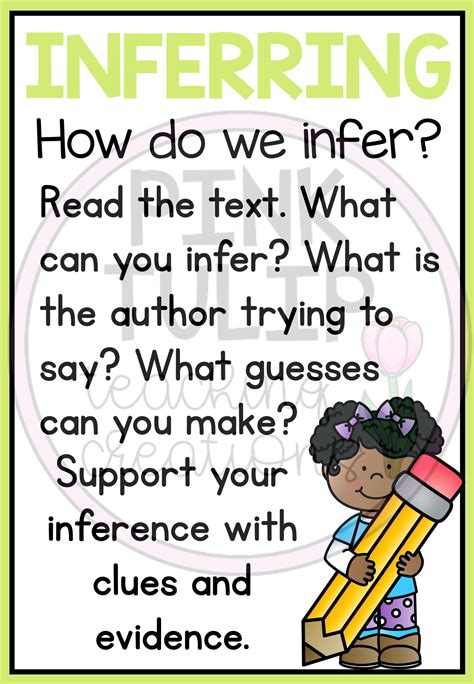In the realm of reading comprehension, inference plays a crucial role in extracting deeper meaning and creating a comprehensive understanding of a text. By inferencing, readers can connect the dots between explicit information and draw logical conclusions that are not explicitly stated. To master the art of inference, readers should cultivate a keen eye for detail, a thirst for context, and a methodical approach to their reading.

Grasping the Basics of Inference
Inference is the process of deriving conclusions or making assumptions based on information that is not directly provided. It involves reading between the lines, connecting the dots, and drawing logical conclusions. By inferencing, readers can fill in the gaps in a text and gain a deeper understanding of the author’s intent, characters’ motivations, and the overall significance of events.
Essential Considerations for Effective Inferencing
1. Attention to Detail:
Paying close attention to every word, phrase, and passage is paramount for successful inferencing. Readers should note key words, phrases, and sentences that provide clues to the author’s intent.
2. Contextual Awareness:
Understanding the context of a passage is essential for accurate inferencing. Readers should consider the historical period, cultural background, and literary genre of a text to gain a deeper understanding of the author’s perspective and the meaning behind the words.
3. Logical Reasoning:
Applying logical reasoning skills is crucial for making sound inferences. Readers should use evidence from the text to support their conclusions and avoid jumping to hasty generalizations.
4. Textual Clues:
Authors often provide textual clues to guide readers’ inferences. These clues may include:
- Contrasting or comparative statements
- Cause-and-effect relationships
- Figurative language (e.g., metaphors, similes)
- Characterization and dialogue
- Unstated assumptions
A Step-by-Step Approach to Inference
1. Read Actively:
Engage with the text actively by highlighting key words, annotating passages, and asking questions.
2. Identify Explicit Information:
Determine the facts and details that are explicitly stated in the text.
3. Examine Contextual Clues:
Look for clues provided by the historical, cultural, and literary context of the text.
4. Draw Tentative Conclusions:
Form preliminary conclusions based on the evidence and clues gathered.
5. Support Conclusions with Evidence:
Provide specific examples from the text to support your inferences.
6. Revise and Refine:
Evaluate your conclusions and make revisions as necessary based on further analysis of the text.
Strategies for Enhanced Inferencing
1. Mind Mapping:
Create mind maps to visualize connections between ideas and draw inferences.
2. Summarizing:
Summarizing key points and identifying supporting evidence can help strengthen inferences.
3. Questioning:
Asking questions about the text and its implications can prompt readers to explore deeper meanings.
4. Predictive Reading:
Anticipating what might happen next based on the information provided can enhance inferencing skills.
Benefits of Mastering Inference
1. Deeper Text Comprehension:
Inference improves comprehension by filling in the gaps and creating a more comprehensive understanding of a text.
2. Enhanced Critical Thinking:
Inferencing requires critical thinking skills, such as analysis, synthesis, and evaluation.
3. Improved Reader Engagement:
Active inferencing makes reading more engaging and enjoyable for readers.
4. Stronger Writing Skills:
By learning to draw inferences, readers can develop stronger writing skills by supporting their arguments with logical reasoning and evidence.
The Need for Cultural Sensitivity
When making inferences, it is crucial to be culturally sensitive and aware of the perspectives and beliefs of different cultures. Making assumptions based on stereotypes or biases can lead to inaccurate or insensitive interpretations.
Consider the following excerpt from Harper Lee’s “To Kill a Mockingbird”:
“Atticus was silent for a moment. ‘She’s a good girl, Jem,’ he said at last. ‘It’s just that she sees differently from most folks. She’ll have a hard time if she tries to live up to them.'”
Based on this excerpt, readers can infer that:
- Scout is an unconventional child who views the world differently from others.
- Scout’s non-conformity may make it challenging for her to fit into society.
- Atticus is protective and understanding of Scout’s unique perspective.
Conclusion
Making inferences is an essential skill for proficient reading comprehension. By paying attention to detail, considering context, and applying logical reasoning, readers can unlock the deeper meanings hidden within texts. The strategies and approaches outlined in this guide will empower readers to become more effective inferencers, fostering a deeper understanding of the written word.
